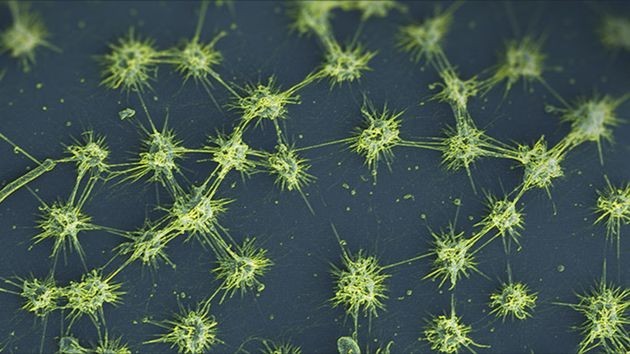Collection |
Collections
Filters
-
Collection Type
-
-
Collection |
 Celebrating 15 Years of The ISME Journal
Celebrating 15 Years of The ISME Journal
This year marks 15 years since the launch of The ISME Journal. During this time, The ISME Journal has grown into a internationally respected and leading title in microbial ecology, publishing major advances and contributing to the global understanding of microorganisms and their communities. In this collection, we present a set of content to commemorate this anniversary. Free to view for the next four weeks, you will find our top cited article each year since the journal launched, and our top downloaded content from the last two years, showcasing the leading research that The ISME Journal has published since its launch, and continues to publish today. We would like to take this chance to thank our authors, reviewers, and readers for their support and contributions to The ISME Journal, and we hope you enjoy reading this collection.
Image: Prof. Christine Moissl-Eichinger, Medical University Graz, Austria -
Award |
 The ISME Journal 2022 Best Paper Award
The ISME Journal 2022 Best Paper Award
As the Editor in Chief team for The ISME Journal, we are committed to promoting excellence in all aspects of our flagship society journal. We strive to ensure rapid handling of manuscripts and quality reviews as we seek to publish the most important discoveries in microbial ecology. As part of this philosophy, we wish to acknowledge and celebrate the most impactful articles in our journal. We use a diverse complement of article metrics related to citations, social media mentions, blog posts, and page accesses in order to shortlist articles that may be deserving of special recognition for a given year. Following this process, we evaluate articles for their content to help reach our final decisions. High impact articles elevate the profile of our journal and highlight exceptional discoveries in the field of microbial ecology and, given the number of major advances that we publish each year, it was particularly difficult to only select three. For the 2022 ISME J Best Paper Award, we Editors in Chief would like to recognize the following three articles for their outstanding quality and impact. We think you will agree that these three articles nicely reflect the breadth of topics that ISME J publishes each year from authors around the world. Lisa Stein, Josh Neufeld, and Jillian Petersen
Image: Prof. Christine Moissl-Eichinger, Medical University Graz, Austria -
Award |
 The ISME Journal 2020 Best Paper Award
The ISME Journal 2020 Best Paper Award
As the newly appointed Editor in Chief team for The ISME Journal, we are committed to promoting excellence in all aspects of our flagship society journal. We strive to ensure rapid handling of manuscripts and quality reviews as we seek to publish the most important discoveries in microbial ecology. As part of this philosophy, we wish to acknowledge and celebrate the most impactful articles in our journal. We use a diverse complement of article metrics related to citations, social media mentions, blog posts, and page accesses in order to shortlist articles that may be deserving of special recognition for a given year. Following this process, we evaluate articles for their content to help reach our final decisions. High impact articles elevate the profile of our journal and highlight exceptional discoveries in the field of microbial ecology and, given the number of major advances that we publish each year, it was particularly difficult to only select three. For this inaugural 2020 ISME J Best Paper Award, we Editors in Chief would like to recognize the following three articles for their outstanding quality and impact. We think you will agree that these three articles nicely reflect the breadth of topics that ISME J publishes each year from authors around the world. ********************************* Cristina Howard-Varona, Morgan M. Lindback, G. Eric Bastien, Natalie Solonenko, Ahmed A. Zayed, HoBin Jang, Bill Andreopoulos, Heather M. Brewer, Tijana Glavina del Rio, Joshua N. Adkins, Subhadeep Paul, Matthew B. Sullivan, Melissa B. Duhaime. Phage-specific metabolic reprogramming of virocells. 14, 881–895. Andy O. Leu, Chen Cai, Simon J. McIlroy, Gordon Southam, Victoria J. Orphan, Zhiguo Yuan, Shihu Hu, Gene W. Tyson. Anaerobic methane oxidation coupled to manganese reduction by members of the Methanoperedenaceae. 14, 1030–1041. Liam M. Rooney, William B. Amos, Paul A. Hoskisson, Gail McConnell. Intra-colony channels in E. coli function as a nutrient uptake system. 14, 2461–2473. ********************************* The above three articles, plus all articles that reached our shortlist are included in this collection. Josh Neufeld, Lisa Stein and Kazuya Watanabe
Image: Prof. Christine Moissl-Eichinger, Medical University Graz, Austria -
Focus |
 Readers' Choice: The best of The ISME Journal 2019
Readers' Choice: The best of The ISME Journal 2019
See what scientists world-wide have been citing and sharing. In this Web Focus we highlight a selection of articles from 2019, which top the list of the journal’s most cited and most shared (including press coverage, blogs, Twitter, Facebook and Weibo). They showcase the breadth of scope and coverage that the journal consistently delivers to its readers.
Image: Prof. Christine Moissl-Eichinger, Medical University Graz, Austria -
Focus |
 Readers' Choice: The best of The ISME Journal 2018
Readers' Choice: The best of The ISME Journal 2018
See what scientists world-wide have been citing and sharing. In this Web Focus we highlight a selection of articles from 2018 which top the list of the journal’s most cited and most shared (including press coverage, blogs, Twitter, Facebook and Weibo). They showcase the breadth of scope and coverage that the journal consistently delivers to its readers.
Image: Prof. Christine Moissl-Eichinger, Medical University Graz, Austria -
Focus |
 Focus on India
Focus on India
In light of the 59th International Conference of the Association of Microbiologists of India, where ISME will be present from 9-12 December, we are very pleased to present 10 excellent articles recently published in The ISME Journal.
Image: Prof. Christine Moissl-Eichinger, Medical University Graz, Austria -
Collection |
 Papers of interest from The ISME Journal and Nature Microbiology
Papers of interest from The ISME Journal and Nature Microbiology
Here is a collection of some key papers for you to view for free from ISMEJ and Nature Microbiology to coincide with the ISME17 meeting currently on at the Congress Centre in Leipzig, Germany.
Image: Prof. Christine Moissl-Eichinger, Medical University Graz, Austria -
Focus |
 Editors' Choice: The best of The ISME Journal 2016-2017
Editors' Choice: The best of The ISME Journal 2016-2017
In this Web Focus we highlight a selection of articles from 2016 and 2017 which top the list of the journal’s most cited and most shared (including press coverage, blogs, Twitter, Facebook and Weibo). They showcase the breadth of scope and coverage that the journal consistently delivers to its readers.
Image: Prof. Christine Moissl-Eichinger, Medical University Graz, Austria -
Focus |
 Focus on China
Focus on China
In light of the annual Conference of the Chinese Society for Microbial Ecology we are very pleased to present 5 excellent Chinese articles recently published in The ISME Journal. We hope you will enjoy reading these articles as much as we have. The event takes place between 18-25 October.
Image: Andrew Brookes/Cultura/Getty Images Plus -
Focus |
 Mini Journal Focus
Mini Journal Focus
Once again our co-editors-in-chief have selected 5 great articles that represent what the ISME Journal is all about. Microbial ecology is a booming science, gaining relevance across a range of topics affecting our world and the people who live in it, and the ISME Journal strives to reflect the diverse and multidisciplinary developments in the field. This compilation of manuscripts seeks to reflect this diversity and relevance; from the Deepwater Horizon oil spill and the human microbiome to soil fungi, litter decomposition and greenhouse gas emissions. We hope you enjoy reading these articles as much as we have!
Image: Prof. Christine Moissl-Eichinger, Medical University Graz, Austria -
Focus |
 Stewards of a Changing Planet: Commentaries from ISME13 Plenary Lecturers
Stewards of a Changing Planet: Commentaries from ISME13 Plenary Lecturers
To highlight aspects of the importance of microorganisms for our health and the environment, the ISME13 Symposium (August 22-27, 2010, Seattle, WA, USA) invited leading experts to provide plenary lectures on current topics in microbial ecology. The plenary lecturers were also invited to contribute commentaries to the ISME Journal that reflect the content of their lectures. The commentary topics include discussions at the microscopic scale, such as biofilms, mycorrhizae and ecological strategies of big sulfur bacteria, to macroscale discussions of impacts of a changing climate on the microbial communities in oceans and the Arctic. Processes of interest include bacterial and archaeal contributions to ammonia oxidation as well as model systems to study host microbe interactions in the gut. In summary, this unique collection of commentaries describes examples of current trends in the field of microbial ecology and provides important guidance for future research.
Image: Prof. Christine Moissl-Eichinger, Medical University Graz, Austria
